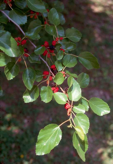Morus rubra: Red Mulberry
 Latin name: Morus rubra
Latin name: Morus rubra
Common name: Red mulberry
Flowers: Small greenish flowers on catkin-like spikes12
Fruit or cones: Red to purple 1” long fruits on female trees8
Height & Width: 40-70’ x 40-50’8
Type: Deciduous8
Wetland indicator category** or ***: FAC17
Habit: Upright-rounded10, 12
Texture: Medium to coarse12
Growth rate: Medium18
Light: Full sun to part shade10, 12
Moisture: Medium12
Soil*: Tolerates a variety of soil types10
Zones: 5 - 98
Origin: Midwestern to Southeastern United States, including South Carolina16
Features: Red mulberry is a medium-sized understory tree that provides sweet, edible fruits for human and animal consumption8, 12. The inconspicuous flowers are a nectar source for butterflies, but the fruit is especially beneficial to songbirds.8, 12
Siting: Morus rubra performs best in rich, moist soil with full sun to part shade conditions8, 12. Female trees should be placed where fruit mess and stains will not be a nuisance.12
Care: Plant so root flare is visible at soil surface14. At planting, water the root ball daily with two gallons of water per inch of trunk diameter for two weeks, every other day for two months and then weekly until established. Modify water recommendations to reflect site drainage and rainfall. Apply 3” of mulch over the planted area. Do not allow mulch to touch the trunk.14
Pests: Bacterial blight on leaves, leaf spots, cankers, powdery mildew, mites and borers are possible pests, especially in southern states8, 12.
Author: Allison Kelly
Sources 1-18 found on Sources page
